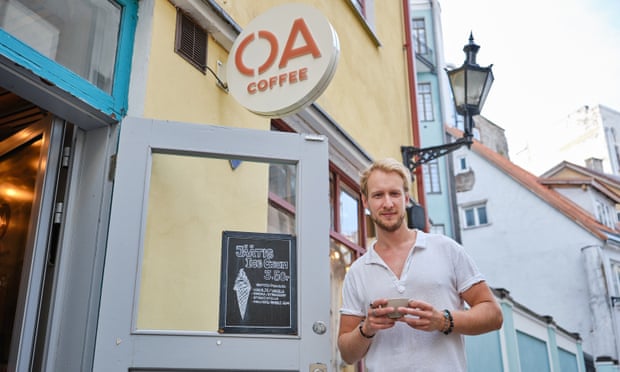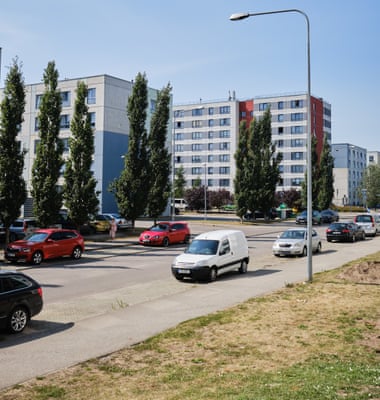‘I’m always looking over my shoulder’: anxiety among Estonia’s Russians
[ad_1]
Father Grigory Borisov offers a prayer for Ukraine every day in a special liturgy at the Lasnamäe church, a towering, whitewashed place of Russian Orthodox worship in the centre of the most populous suburb of Estonia’s capital, Tallinn, where a majority are Russian speakers.
The Church of the Icon of the Mother of God was built in 2013 with the help of funds from a Moscow-based NGO. While in March the Estonian Orthodox church joined other churches in the Baltic country in condemning the bombing of civilians in Ukraine, the church’s leader back in Moscow, Patriarch Kirill, has been accused of providing theological cover for Vladimir Putin’s war.
Borisov, 32, who went to theological college in St Petersburg, is treading a thin line. He says he is not permitted to talk about politics and the war. But the priest concedes there is widespread anxiety in his congregation in this economically deprived part of the city. “The mental health situation is bad – Covid, war, the economic situation, the gas prices. These things make people sad and worried.”
Borisov says he treats everyone who comes to the church the same, whether Estonian, Ukrainian or Russian. “There is neither Greek [n]or Jew,” he says, quoting a passage in the King James Bible that goes on to argue that “all [are] one in Christ Jesus”.

Outside Lasnamäe’s imperiously situated church in the east of Tallinn, among high-rise apartment blocks as far as the eye can see, such blandishments contrast sharply with the reality of what is an increasingly anxious Russian community that is caricatured by some as a “fifth column” and among whom there is in turn a high degree of distrust of the state.
Estonia was a Soviet republic from 1944 until 1991, and about 322,000 of its population of 1.3 million people self-identify as ethnic Russians, with 90,000 having Russian citizenship. Many ethnic Russians turn to Russian television for their news, and a high degree of segregation remains.
Meanwhile, Estonia’s government, led by Kaja Kallas, has taken a strong line on the need to turn the screw on Russia by strengthening the economic sanctions imposed by the west on its economy, ban travel visas for the country’s nationals and tear down Soviet Union imagery, such as monuments commemorating the second world war.

It is a dynamic that risks dangerous misunderstandings taking hold in which opposition to Putin’s Russia could be interpreted as disapproval of Russians at large.
Karsten Brüggemann, a professor of Estonian history at Tallinn University, said the financial assistance being offered to Ukrainian refugees was also being seen as a threat by some in the Russian community.
“Because they see how much money the state is giving to Ukrainian refugees and they haven’t got anything”, he says. “[For] some of the Russians who are in a socioeconomically poor situation this really is quite irritating to say the least.”
Hanging out her washing on the terrace of her ground-floor flat in the shadow of Lasnamäe’s church, one 39-year-old mother of a three-year-old and five-year-old, who declined to give her name, said she was born in Tallinn but identified as Russian. “I better be careful what I say because they will deport me,” she said.
“It was fine before the war. I worked for two Estonian companies and it was good but now we are seen as dangerous. What are they going to do to us next? I am not in favour of the EU sanctions. They are not hurting Russia but hurting us here. I am a personal trainer and I can’t afford to drive to work. I only take the car with the children. I can’t afford to fill it up. The government should be looking after its own people not the Ukrainians who threaten us, who protest with blood over themselves outside the Russian embassy. I am always looking over my shoulder.”
The woman had heard false claims that the Estonian government had stopped free meals for children in Russian-language schools. “I don’t know if it is true, but it could be true,” she insisted.
A flashpoint between the Estonian government and the ethnic Russian community was the move last week to remove a Soviet-era T-34 tank from its pedestal in the eastern city of Narva, where 95.7% of the population of Narva are native Russian speakers and 87.7% are ethnic Russians.

The decision was made as part of a wider plan to relocate between 200 and 400 public monuments to museums on the grounds that Moscow’s invasion of Ukraine had “opened wounds in our society that these communist-era monuments remind us of”.
There had been concerns about unrest. The relocation of a statue known as the Bronze Soldier in Tallinn in April 2007 led to two nights of rioting in the capital’s old town, during which a Russian protester was killed.
This time, locals instead gathered peacefully to lay flowers where the tank had sat. Polls have suggested that adherence of ethnic Russians to the Kremlin line is far from sure since the war. A recent survey found that around a third of those who identify as Russians in Estonia agree with the relocation of Soviet monuments from public places to museums. But fears of trouble remain. Russian hacker group Killnet has claimed to be behind what Estonian officials said was a major but futile cyber attack on its institutions in the immediate wake of the tank’s relocation. On Monday, Russian investigators stated that the murder in Bolshie Vyazyomy near Moscow of Darya Dugina, the daughter of an ultranationalist Russian ideologue had been carried out by a Ukrainian woman who they said travelled to Estonia after the killing.
Katri Raik, a former government minister who has been mayor of Narva since 2020, said there was genuine nervousness in the Russian community that they would be caught in the cross fire between Moscow and Tallinn.
“Now it is very important what happens next,” she told Estonia’s largest daily newspaper, Postimees. “Those red monuments are [no longer] there. Is that all now? Or what the Estonian state has in mind in the direction of Narva. We need to restore trust between the country of Estonia and Narva.”
Raik added: “We have to get rid of the fear of the people of Narva, which many people expressed yesterday at various meetings. They are afraid that they will be sent away from Estonia. We will certainly not send away the people of Narva”.
Speaking on Estonian Independence Day on Saturday, the country’s president, Alar Karis, spoke of the ill will stirred up by the removal of the tank. “We must acknowledge that some residents of our country do have a different historical understanding,” he said. “Many of our compatriots are not yet fluent in Estonian, but in addition to the language, or greatly due to not speaking it, they also have not been taught an ideologically unbiased history of Estonia, Europe and the world.”
He called, however, for understanding and sensitivity at a time when nuance was easily lost. “There are 1.3 million of us,” he said. “We possess power and strength. But only if we go forward taking heed of one another, not elbowing our own truth through.”
[ad_2]
Read More:‘I’m always looking over my shoulder’: anxiety among Estonia’s Russians

Comments are closed.